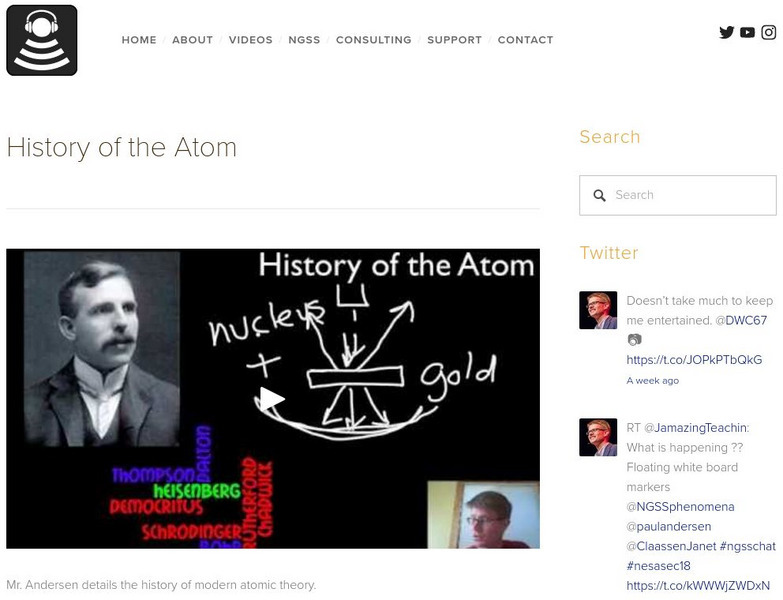TED-Ed
Periodic Videos
From hydrogen to ununoctium, this collection of videos has everything you need to begin teaching about the periodic table. Offering descriptions of each element and interesting experiments...
Veritasium
Thomson's Plum Pudding Model of the Atom
JJ Thomson discovered atoms are made up of things, which he called electrons. The video in the Vertasium playlist explains Thomson's model of the atom, known as the plum pudding model. It presents the new knowledge Thomson wanted to...
JFR Science
Development of Atomic Theory: An Introduction
The atom has come a long, long way! From its early days as a ball of goo that exhibited the same properties as the whole it was part of, to the tiny sphere we know today, atomic theory has truly evolved. Explore these changes with an...
Domain of Science
The Map of Physics
Aristotle said, "The more you know, the more you know you don't know." Physics includes everything from the laws of motion to quantum gravity. An interesting video attempts to cover the main concepts of every branch of physics in only a...
Veritasium
Atomic Theory
"I would rather have questions that can't be answered than answers that can't be questioned." - Richard Feynman. The video by Veritasium presents one of these questions, proposed by Feynman, along with his answer. It discusses the...
Fuse School
The Atom: Part 3 - What Is an Atom?
Explore the idea of an atom through a short video lesson. The instructor describes an atom and its connection to an element. By comparing atoms to a room of balloons, the video emphasizes that if an atom is cut in half, it no longer has...
Bozeman Science
History of the Atom
Viewers learn about the history of our knowledge of atoms through the discoveries of eight different scientists: Mendeleev, Democritus, Dalton, Thompson, Schrodinger, Bohr, Rutherford, and Chadwick.
TED-Ed
Einstein's Miracle Year
Why was Albert Einstein initially labeled as a "failed" academic, and what events occurred in 1905 that constituted a major turning point for this great scientist? Review Einstein's major theories regarding relativity, light...
TED-Ed
The 2,400-Year Search for the Atom
From ancient Greek philosophers to early American Quakers, people have sought to understand the composition of matter for millennia. Follow along with this video as it explores the long scientific journey that eventually led to the...
PBS
Pbs Learning Media: Melissa Franklin: High Energy Physics
This video segment adapted from Discovering Women profiles Fermilab physicist and Harvard professor Melissa Franklin. [4:08]
Khan Academy
Khan Academy: The History of Atomic Chemistry
Video tutorial explores and explains the story of Atomic Chemistry and how we got here. [8:46]
Sophia Learning
Sophia: Democritus: Lesson 1
This lesson will describe Democritus' description of matter being discontinuous. It is 1 of 3 in the series titled "Democritus."
Crash Course
Crash Course Chemistry #37: The History of Atomic Chemistry
From Leucippus to Heisenberg to modern day chemists, Hank takes us on a tour of the folks that were part of the long chain of other folks who helped us get to these deeper understandings of Atomic Chemistry. [9:42]
Sophia Learning
Sophia: Development of the Early Atomic Theory
Get a quick overview of atomic theory, from early theories to modern understanding of the atom. [1:10]
Sophia Learning
Sophia: Electron Placement in an Atom
This in-depth video tutorial explains the rules for filling orbitals with electrons in an atom. [11:28]
Khan Academy
Khan Academy: The History of Atomic Chemistry
How did we get here? Well, in terms of Atomic Chemistry, Hank takes us on a tour of the folks that were part of the long chain of other folks who helped us get to these deeper understandings of the world. From Leucippus to Heisenberg to...
Sophia Learning
Sophia: Democritus: Lesson 3
This lesson will describe Democritus' description of matter being discontinuous. It is 3 of 3 in the series titled "Democritus."
Sophia Learning
Sophia: Development of the Early Atomic Theory: Lesson 4
This lesson will briefly summarize the early history of the atomic theory including Democritus, John Dalton, JJ Thomson, and Ernest Rutherford.. It is 4 of 4 in the series titled "Development of the Early Atomic Theory."
Sophia Learning
Sophia: John Dalton: Lesson 3
This lesson reviews Dalton's Atomic Theory and explains each of the points.. It is 3 of 3 in the series titled "John Dalton."
Bozeman Science
Bozeman Science: History of the Atom
Mr. Andersen details the history of modern atomic theory.
Bozeman Science
Bozeman Science: Ap Chemistry: Atomic Models
Paul Andersen explains how the atomic model has changed over time. A model is simply a theoretical construct of phenomenon and so when we receive new data we may have to refine our model. Ionization energy data resulted in the formation...
Bozeman Science
Bozeman Science: Ap Chemistry: Mass Spectrometry
In this video, Paul Andersen explains how a spectrometer was used to identify the presence of isotopes. This modified Dalton's original atomic theory because atoms of the same element had different masses. The functional parts of a mass...
Bozeman Science
Bozeman Science: Atoms & the Periodic Table
Mr. Andersen describes atomic structure and tours the periodic table. [9:15]






















